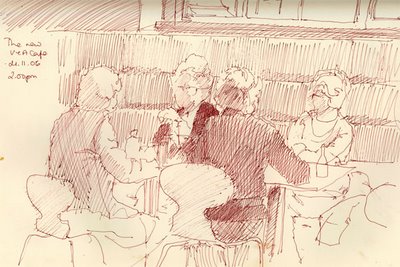So far I've looked at what I learned about the
support and the drawing,
the pigments and the grinding to create the egg tempera paint - now we get to the actual painting! Working in egg tempera on a panel in class over two days - at the same time as learning about the paint and how to to use it - had some pluses and minuses - which I'll indicate below.
Who is most likely to like egg tempera painting?
I think I'd recommend egg tempera painting for people who don't need quick results and who have the patience to work through quite a few mistakes before they get it right. I know I came away with nothing but the utmost admiration for contemporary artists who produce large works in egg tempera (eg
Andrew Wyeth;
David Tindle)
Egg tempera seemed to me to belong very much to the age when artists had to know a lot about craft as well as a lot about art and will certainly appeal to those who like the craft aspect of art media. This is the very first time in a class that I've had a sense of what a studio of old might be like. Once we got going, people were cracking eggs and grinding paint for the next section they were going to paint as well as painting. We all ended up agreeing that while very enjoyable, having 15 year old apprentices to do all of that (as well as preparing the gesso panels and making the brushes) did seem like a jolly good idea!
How much paint to mix
One of the pluses of being in a workshop was that we soon learned to share the egg tempera we had made. Invariably people found that they were making up much more than they needed at the beginning - but it was all put to good use - albeit on somebody else's panel!
I'd certainly recommend that it's seems best to be very judicious about much paint you grind and mix to start with. The guiding principle seems to be to produce no more than you expect to use that day - given that you're using egg yolk as the binder.
The bonus of using good quality watercolours as your basic 'paste' to mix with egg yolk is that this consideration does not apply. However it does create a different problem - one of wanting to work faster than the paint allows - which was a trap which I well and truly fell into. Given the problems that the grinding presented for my tenosynovitis, after I ground two lots of paint I decided on the second day to work just with watercolour paints, forgetting of course just how long it is since I've worked in watercolour! Getting tops off paint tubes was 'interesting'! Here's my set-up at the start of the second day.
 |
My set-up for painting with egg tempera on a gesso panel
workshop at Victoria and Albert Museum
© Katherine Tyrrell |
Planning the painting is essential
Prof Wallace advised that when working with egg tempera she would normally expect to take between a week and 10 days to do a small piece. In practical terms this would typically mean working on three tones of one colour at a time and maybe no more than two colours in one day
This makes planning the painting interesting. You need to think about which pigments you are going to use, which pigments you are going to mix, how many tones you will create for each colour, which colours and values you are going make adjacent - a very important consideration for creating light an dark in a painting with a limited number of tones; which order to apply colours; etc. One of the effects of egg tempera is that it makes the paints very bright - but in renaissance times paintings would have been viewed by candle light (maybe a maximum of 50 lux) and needed to be bright. It would never be seen under artificial light.
The negative side of working in class was essentially about the time limits - we were producing a work on a panel in less than two days. One lady solved this problem by very sensibly using her panel to try out different small paintings using different colours and with different effects. I'd certainly commend this approach for people starting to use egg tempera for the first time.
How to apply the paint
The really difficult bit about egg tempera is working out how much more egg to use with each emulsion mix and and how many drops of water are required to make the paint work properly. It varies with each pigment and seems to be very much a case of trial and error which cannot be avoided. This is also the bit where being in a workshop and having a very experienced tutor in the room with you as you are starting out saves a lot of time in learning terms. Professor Wallace was an absolutely invaluable resource!
The other issue is about how to mix colours. The trick here seems to be to get both primary pigments to the viscosity of thick cream first before mixing. This is because different pigments absorb different amounts of water before they become smooth and creamy. Thus they can be mixed only after they have achieved the requisite level of creaminess.
Basic application seems to work as follows (bearing in mind I am still very much a novice at this):
- use one colour at a time to develop three tones - dark value, middle value and a light value
- start with fresh egg tempera every day
- wet the brush and dry it on paper so it is moist.
- pick up some emulsion and place in a palette and then add as much egg or water as is required to make it less viscose painting mix.
- Ideally use distilled water when using egg tempera.
- Use small brush strokes. Traditionally, the ideal was to avoid any sense of brush strokes - so in this context blending as you paint is desirable. More contemporary painters allow us to see the brush strokes and some practice optical mixing
- never try to paint in a long line of equal weight - the brush loses the paint very fast.
- always clean the brush in a different pot of water before adding clean water from a second pot to the mix
- never leave a brush with egg tempera paint on (think egg yolk left on breakfast plates); always clean before putting it down ( clean in 'dirty water'; then dip in clean water and then lay down on absorbent paper or rag
I personally found that the disposable wooden spatulas which came with the V&A tea and coffee were absolutely spot on for use in extracting some paste/yolk/water and then mixing!
While doing the workshop and generally researching egg tempera on the internet I came across or was given links to some excellent demonstrations of how to paint using egg tempera
What to do if it all goes wrong
This is my own personal contribution to painting with egg tempera!
Some of the reasons it can go wrong:
- the application looks patchy and/or gritty.
- The solution: check out the background in Fred Wessell's demo and also see my comments below about the potential for the use of fine sandpaper.
- too much water has been used. Watercolour mixed with watercolour paints and egg yolk lifts off the previous layer and can quickly result in a gesso hole. I found out the hard way!
- Solution: when using watercolour paints use much less egg yolk to produce the egg tempera emulsion and don't use any water at all!
- the egg tempera emulsion had dried out. Once a film has formed then you are potentially in trouble.
- Solution: keep the base emulsion covered with cling film while working and use a small amount only in a mixing palette (we used oyster shells)
- egg tempera can be rather mobile and you can get spots on your painting - I did!
- try lifting off with kitchen paper and sanding back and then painting over. This doesn't always work
Working in a group meant we also got the feedback which came from people finding something out from the application of the paint. For example, I asked Prof Wallace how I should approach my panel given the large amount of background and she advised that doing it first would be best - with verdigris mixed only with water. Which I did, but the verdigris is a very gritty pigment and I maybe didn't grind it well enough as my background looked very dark and gritty. Until I discovered the wonders of sanding back using a very fine sandpaper! After that I had a very nice (albeit rather patchy) turquoise background - and I became a firm advocate of the creative use of very fine sandpaper with egg tempera! Verdigris is also apparently a pigment best used under other colours - presumably because it is so difficult to get smooth.
I also found that I needed to be very careful in making sure that a coat had dried fully before applying the next one. I kept getting a gooey mess - partly because I think I was making scrambled eggs on my panel. I did however find that one can remove a gooey mess using sandpaper - and battery powered erasers work very well as well! I removed the pear at the centre of my painting three times getting back to smooth gesso on each occasion.
 |
Egg Tempera painting on Gesso Panel
- indicating the results of removing a gooey mess!
workshop at Victoria and Albert Museum
© Katherine Tyrrell |
Varnish
It's generally recommended that egg tempera paintings should be left for as long as possible before varnishing. I've got a note which indicates that the varnish for egg tempera should be egg yolk and water and again Ceninno Cennini has
a recipe and an approach for varnishing.
What can be achieved in class
I'm going to finish by posting a photo of the panel which was produced by the chap I sat next to in the workshop. Vincent Daniels is a chemist by profession and works as a Research Fellow in Conservation; he developed a copy of a Fra Angelico piece. The brighter blue in the wings is lapis lazuli and I think the darker blue was alizarin crimson over the lapis lazuli. The background was red ochre covered by a gold paint. I think it's jolly good and much better than mine! I tried to work too fast and experimented a lot and Vincent just got on with a lot of thought and very steady application - I'm very sure he'll make an excellent painter using egg tempera if he persists with it!
 Links:
Links:
- Artists:
- Demonstrations in stages with images of the technique of painting in egg tempera
















